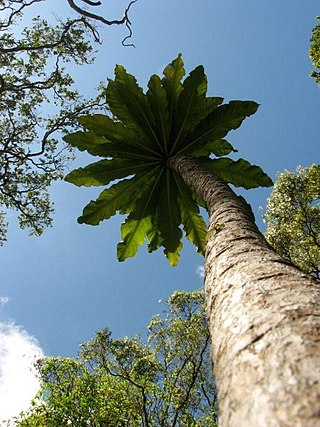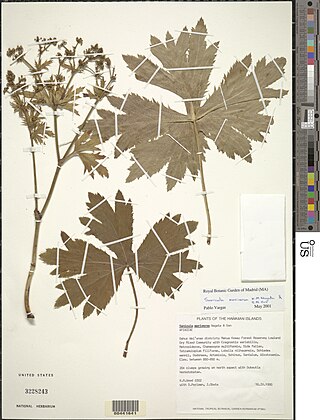Cyanea glabra is a rare species of flowering plant in the family Campanulaceae known by the common name smooth cyanea. It is endemic to Maui, where there are twelve plants remaining in the wild. It was federally listed as an endangered species of the United States with nine other Maui Nui endemics in 1999. Like other Cyanea it is known as haha in Hawaiian.
Cyanea procera is a rare species of flowering plant in the bellflower family known by the common name Molokai cyanea. It is endemic to Hawaii, where it is known only from the island of Molokaʻi. It is a federally listed endangered species of the United States. Like other Cyanea it is known as haha in Hawaiian.
Cyanea st.-johnii is a rare species of flowering plant in the bellflower family known by the common name St. John's rollandia. It is endemic to Oahu, where it is known only from the Koʻolau Mountains. It is a federally listed endangered species of the United States. Like other Cyanea it is known as haha in Hawaiian.

Cyanea superba is a rare species of flowering plant in the bellflower family known by the common names Mt. Kaala cyanea and superb cyanea. It is endemic to the island of Oahu, but it is now extinct in the wild. It exists in cultivation and some individuals have been planted in appropriate habitat. It is a federally listed endangered species of the United States. Like other Cyanea it is known as haha in Hawaiian.

Cyanea truncata is a rare species of flowering plant in the bellflower family known by the common name Punaluu cyanea. It is endemic to the islands of Oahu and Molokai in Hawaii, but it is now critically endangered. It exists in cultivation and some individuals have been planted in appropriate habitat. It is a federally listed endangered species of the United States. Like other Cyanea it is known as haha in Hawaiian.

Cyrtandra is a genus of flowering plants containing about 600 species, with more being discovered often, and is thus the largest genus in the family Gesneriaceae. These plants are native to Southeast Asia, Australia, and the Pacific Islands, with the centre of diversity in Southeast Asia and the Malesian region. The genus is common, but many species within it are very rare, localized, and endangered endemic plants. The species can be difficult to identify because they are highly polymorphic and because they readily hybridize with each other. The plants may be small herbs, vines, shrubs, epiphytes, or trees. The genus is characterized in part by having two stamens, and most species have white flowers, with a few red-, orange-, yellow-, and pink-flowered species known. Almost all species live in rainforest habitats.
Cyrtandra crenata is a rare species of flowering plant belonging to the African violet family known by the common name Kahana Valley cyrtandra. It is endemic to Oahu in Hawaii, where it is known to be found only from the Koolau Mountains. It has not been seen since 1947, however, and it is feared to be extinct. The habitat is steep and inaccessible in some areas, so it is possible that specimens of this species still exist in the wild. It was federally listed an endangered species of the United States in 1994. This shrub grows 1 to 2 meters tall and bears white flowers. Like other Hawaiian Cyrtandra it is called ha`iwale.

Cyrtandra cyaneoides is a rare species of flowering plant in the African violet family known by the common name māpele. It is endemic to Kauaʻi in Hawaiʻi, where it is known from eleven populations containing a total of under 800 individual plants. Several of these were discovered between 2003 and 2008. It is a shrub that grows 1 to 6 meters tall, bears white flowers, and egg-shaped berries. It was federally listed as an endangered species in 1996.
Cyrtandra dentata is a rare species of flowering plant in the African violet family known by the common names mountain cyrtandra and sharp-toothed cyrtandra. It is endemic to Oahu in Hawaii, where the most recent count estimates 1640 plants occurring in the Waianae Mountains and Koʻolau Mountains. It is a shrub which can reach 5 meters tall and bears white flowers. It was federally listed as an endangered species in 1996. Like other Hawaiian Cyrtandra it is called ha`iwale.
Cyrtandra giffardii is a rare species of flowering plant in the African violet family known by the common names forest cyrtandra and Giffard's cyrtandra. It is endemic to the island of Hawaii, where it grows on the slopes of Mauna Kea and Mauna Loa. A 1998 estimate places the total remaining population size around 1000 individual plants. It is a tree which grows 2 to 6 meters tall and bears white flowers. It was federally listed as an endangered species in 1994. Like other Hawaiian Cyrtandra it is called ha`iwale.
Cyrtandra munroi is a rare species of flowering plant in the African violet family known by the common names Lanaihale cyrtandra and Munro's cyrtandra. It is endemic to Hawaii, where it is known from the islands of Lanai and Maui. There are fewer than 50 individuals remaining in the wild. It is a shrub with hairy leaves and white flowers. It was federally listed as an endangered species in 1992. Like other Hawaiian Cyrtandra it is called ha`iwale.
Cyrtandra oenobarba is a rare species of flowering plant in the African violet family known by the common name shaggystem cyrtandra. It is endemic to Hawaii, where it is known only from the island of Kauai. It can be found in only three localized areas of the island and there are fewer than 500 individuals remaining in the wild. It was federally listed as an endangered species in 2010. Like other Hawaiian Cyrtandra it is called ha`iwale.
Cyrtandra paliku is a rare species of flowering plant in the African violet family known by the common name cliffside cyrtandra. It is endemic to Hawaii, where it is known only from the island of Kauai. The plant was first discovered in 1993 and it was described to science as a new species in 2001. At the time it was discovered there was only one population containing 70 individuals; a 2006 count revealed only ten plants remaining. It was federally listed as an endangered species in 2010. Like other Hawaiian Cyrtandra it is called ha`iwale.
Cyrtandra polyantha is a rare species of flowering plant in the African violet family known by the common names Niu Valley cyrtandra. It is endemic to the Hawaii, where it is known only from the Koʻolau Mountains of Oahu. In 2007 there were only two populations containing a total of 46 mature plants, but one of the two populations is made up of a single individual. It was federally listed as an endangered species in 1994. Like other Hawaiian Cyrtandra it is called ha`iwale.
Cyrtandra subumbellata is a rare species of flowering plant in the African violet family known by the common name parasol cyrtandra. It is endemic to Hawaii, where it is known only from the Koʻolau Mountains on the island of Oahu. By 2008 there were three known populations containing 110 plants, or possibly more. It was federally listed as an endangered species in 1996. Like other Hawaiian Cyrtandra it is called ha`iwale.
Cyrtandra tintinnabula is a rare species of flowering plant in the African violet family known by the common name Laupahoehoe cyrtandra. It is endemic to the island of Hawaii, where it is known only from the slopes of Mauna Kea. As of 1996 there were only three occurrences containing fewer than 20 individuals total. It was federally listed as an endangered species in 1994. Like other Hawaiian Cyrtandra it is called ha`iwale.
Myrsine linearifolia is a rare species of flowering plant in the primrose family known by the common name narrowleaf colicwood. It is endemic to Hawaii, where it is known only from the island of Kauai. There are 12 populations remaining, for a total of fewer than 200 plants. Like other Hawaiian Myrsine this plant is called kōlea. It is a federally listed threatened species of the United States.

Sanicula mariversa is a rare species of flowering plant in the family Apiaceae known by the common name Waianae Range black-snakeroot. It is endemic to Hawaii, where it is known only from the Waianae Mountains on the island of Oahu. It is threatened by the degradation of its habitat. It is a federally listed endangered species of the United States.

Sanicula purpurea is a rare species of flowering plant in the carrot family known by the common names purple-flower black-snakeroot and purple-flowered sanicle. It is endemic to Hawaii, where it is known from Maui and from the Koolau Mountains on the island of Oahu. It is threatened by the degradation of its habitat. It was federally listed as endangered species of the United States in 1996.

Silene perlmanii is a rare species of flowering plant in the family Caryophyllaceae known by the common name cliff-face catchfly. It is endemic to Hawaii, where it is known only from the southern Waianae Mountains of Oahu. Today there are no plants left in the wild. The species is in cultivation at the National Tropical Botanical Garden. It is a federally listed endangered species of the United States.






